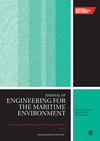双岛型设计对某型航空母舰周围气流动力学影响的数值评估
IF 1.5
4区 工程技术
Q3 ENGINEERING, MARINE
Proceedings of the Institution of Mechanical Engineers, Part M: Journal of Engineering for the Maritime Environment
Pub Date : 2023-06-24
DOI:10.1177/14750902231183198
引用次数: 0
摘要
双岛概念是航空母舰顶层甲板结构的最新创新。航母的钝体设计给飞行员带来了许多困难,在甲板上着陆是最大的问题。本文的研究目的是对通用航空母舰双岛结构的气动性能进行数值分析。利用归一化轴向速度和湍流动能进行了流动表征,以帮助确定沿滑坡线的飞行员工作量。本文采用垂直于流动方向的多个横切面对双岛GAC飞行甲板及其下游的流动进行了分析。然后调查了两个岛屿的纵向平移对初始GAC位置的影响,并根据飞机的着陆进近路径对结果进行了分析和汇编。结果表明,双岛设计优于单岛设计。当分叉的岛屿在纵向上被重新定位在原来的单岛设计位置的前面时,在减少湍流方面取得了最大的优势。改进后的设计不仅实现了72%的峰值湍流减少,而且还为飞行员在接近航母飞行甲板着陆时评估环境条件提供了额外的时间优势,从而有助于高效和有效地管理工作量。本研究结果可为今后双岛概念在浮式结构设计方案中的整合和应用以及该领域的进一步研究提供动力。本文章由计算机程序翻译,如有差异,请以英文原文为准。
Numeric assessment of the effect of the twin island design on the airflow dynamics around a generic aircraft carrier
The twin island concept is the most recent innovation in the top-deck architecture of an aircraft carrier. The carrier’s bluff body design presents the pilot with a number of difficulties, with landing on deck posing the biggest problem. The goal of the current study is to carry out the numerical analysis of the aerodynamic behaviour of twin island structure on Generic Aircraft Carrier. The flow characterization has been performed utilizing the normalized axial velocity and turbulent kinetic energy as aids for establishing pilot workload along the glideslope line. In this paper, multiple transverse planes cut across perpendicular to the flow direction are used to analyse the flow across the flight deck of twin island GAC and its downstream. The impacts of the two islands’ longitudinal translations with regard to the initial GAC position were then investigated and the results were analysed and compiled with reference to the landing approach path of the aircraft. The results show that the twin island designs are preferable to a single island. The maximum advantage in terms of turbulence reduction is achieved when the bifurcated islands are longitudinally repositioned forward of the original single island design position. The modified design not only achieves a 72% reduction in peak turbulence but also provides an additional time advantage to the pilot for assessing the environmental conditions while he is approaching the carrier flight deck for landing thus aiding to efficiently and effectively manage the workload. The findings of this study can act as a driving force for the integration and application of twin island concept in future design plans for floating structures and further studies in the field.
求助全文
通过发布文献求助,成功后即可免费获取论文全文。
去求助
来源期刊

CiteScore
3.90
自引率
11.10%
发文量
77
审稿时长
>12 weeks
期刊介绍:
The Journal of Engineering for the Maritime Environment is concerned with the design, production and operation of engineering artefacts for the maritime environment. The journal straddles the traditional boundaries of naval architecture, marine engineering, offshore/ocean engineering, coastal engineering and port engineering.
 求助内容:
求助内容: 应助结果提醒方式:
应助结果提醒方式:


